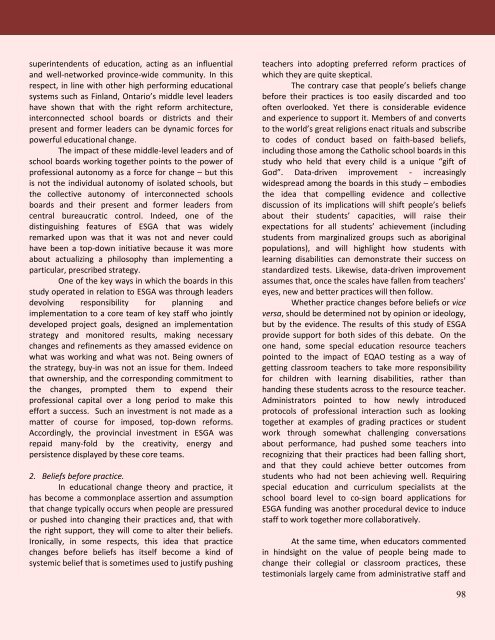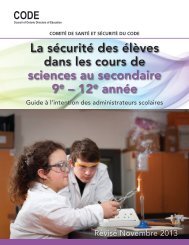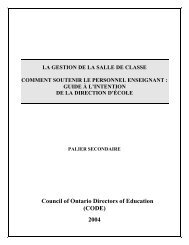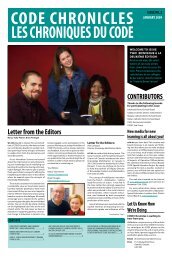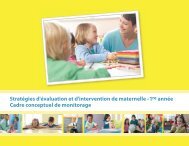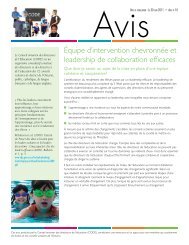superintendents <strong>of</strong> education, acting as an influentialand well-networked province-wide community. In thisrespect, in line with o<strong>the</strong>r high per<strong>for</strong>ming educationalsystems such as Finland, Ontario’s middle level leadershave shown that with <strong>the</strong> right re<strong>for</strong>m architecture,interconnected school boards or districts and <strong>the</strong>irpresent and <strong>for</strong>mer leaders can be dynamic <strong>for</strong>ces <strong>for</strong>powerful educational change.The impact <strong>of</strong> <strong>the</strong>se middle-level leaders and <strong>of</strong>school boards working toge<strong>the</strong>r points to <strong>the</strong> power <strong>of</strong>pr<strong>of</strong>essional autonomy as a <strong>for</strong>ce <strong>for</strong> change – but thisis not <strong>the</strong> individual autonomy <strong>of</strong> isolated schools, but<strong>the</strong> collective autonomy <strong>of</strong> interconnected schoolsboards and <strong>the</strong>ir present and <strong>for</strong>mer leaders fromcentral bureaucratic control. Indeed, one <strong>of</strong> <strong>the</strong>distinguishing features <strong>of</strong> ESGA that was widelyremarked upon was that it was not and never couldhave been a top-down initiative because it was moreabout actualizing a philosophy than implementing aparticular, prescribed strategy.One <strong>of</strong> <strong>the</strong> key ways in which <strong>the</strong> boards in thisstudy operated in relation to ESGA was through leadersdevolving responsibility <strong>for</strong> planning andimplementation to a core team <strong>of</strong> key staff who jointlydeveloped project goals, designed an implementationstrategy and monitored results, making necessarychanges and refinements as <strong>the</strong>y amassed evidence onwhat was working and what was not. Being owners <strong>of</strong><strong>the</strong> strategy, buy-in was not an issue <strong>for</strong> <strong>the</strong>m. Indeedthat ownership, and <strong>the</strong> corresponding commitment to<strong>the</strong> changes, prompted <strong>the</strong>m to expend <strong>the</strong>irpr<strong>of</strong>essional capital over a long period to make thisef<strong>for</strong>t a success. Such an investment is not made as amatter <strong>of</strong> course <strong>for</strong> imposed, top-down re<strong>for</strong>ms.Accordingly, <strong>the</strong> provincial investment in ESGA wasrepaid many-fold by <strong>the</strong> creativity, energy andpersistence displayed by <strong>the</strong>se core teams.2. Beliefs be<strong>for</strong>e practice.In educational change <strong>the</strong>ory and practice, ithas become a commonplace assertion and assumptionthat change typically occurs when people are pressuredor pushed into changing <strong>the</strong>ir practices and, that with<strong>the</strong> right support, <strong>the</strong>y will come to alter <strong>the</strong>ir beliefs.Ironically, in some respects, this idea that practicechanges be<strong>for</strong>e beliefs has itself become a kind <strong>of</strong>systemic belief that is sometimes used to justify pushingteachers into adopting preferred re<strong>for</strong>m practices <strong>of</strong>which <strong>the</strong>y are quite skeptical.The contrary case that people’s beliefs changebe<strong>for</strong>e <strong>the</strong>ir practices is too easily discarded and too<strong>of</strong>ten overlooked. Yet <strong>the</strong>re is considerable evidenceand experience to support it. Members <strong>of</strong> and convertsto <strong>the</strong> world’s great religions enact rituals and subscribeto codes <strong>of</strong> conduct based on faith-based beliefs,including those among <strong>the</strong> Catholic school boards in thisstudy who held that every child is a unique “gift <strong>of</strong>God”. Data-driven improvement - increasinglywidespread among <strong>the</strong> boards in this study – embodies<strong>the</strong> idea that compelling evidence and collectivediscussion <strong>of</strong> its implications will shift people’s beliefsabout <strong>the</strong>ir students’ capacities, will raise <strong>the</strong>irexpectations <strong>for</strong> all students’ achievement (includingstudents from marginalized groups such as aboriginalpopulations), and will highlight how students withlearning disabilities can demonstrate <strong>the</strong>ir success onstandardized tests. Likewise, data-driven improvementassumes that, once <strong>the</strong> scales have fallen from teachers’eyes, new and better practices will <strong>the</strong>n follow.Whe<strong>the</strong>r practice changes be<strong>for</strong>e beliefs or viceversa, should be determined not by opinion or ideology,but by <strong>the</strong> evidence. The results <strong>of</strong> this study <strong>of</strong> ESGAprovide support <strong>for</strong> both sides <strong>of</strong> this debate. On <strong>the</strong>one hand, some special education resource teacherspointed to <strong>the</strong> impact <strong>of</strong> EQAO testing as a way <strong>of</strong>getting classroom teachers to take more responsibility<strong>for</strong> children with learning disabilities, ra<strong>the</strong>r thanhanding <strong>the</strong>se students across to <strong>the</strong> resource teacher.Administrators pointed to how newly introducedprotocols <strong>of</strong> pr<strong>of</strong>essional interaction such as lookingtoge<strong>the</strong>r at examples <strong>of</strong> grading practices or studentwork through somewhat challenging conversationsabout per<strong>for</strong>mance, had pushed some teachers intorecognizing that <strong>the</strong>ir practices had been falling short,and that <strong>the</strong>y could achieve better outcomes fromstudents who had not been achieving well. Requiringspecial education and curriculum specialists at <strong>the</strong>school board level to co-sign board applications <strong>for</strong>ESGA funding was ano<strong>the</strong>r procedural device to inducestaff to work toge<strong>the</strong>r more collaboratively.At <strong>the</strong> same time, when educators commentedin hindsight on <strong>the</strong> value <strong>of</strong> people being made tochange <strong>the</strong>ir collegial or classroom practices, <strong>the</strong>setestimonials largely came from administrative staff and98
special education resource teachers who were eager tochange o<strong>the</strong>r people’s practices (i.e. <strong>the</strong> practices <strong>of</strong>classroom teachers). In this study and elsewhere, <strong>the</strong>reis less evidence <strong>of</strong> ei<strong>the</strong>r teachers or administratorsacknowledging that en<strong>for</strong>ced new practices havechanged <strong>the</strong>ir own beliefs. The principle that practicechanges be<strong>for</strong>e beliefs <strong>the</strong>re<strong>for</strong>e seems to applied byleaders to o<strong>the</strong>r people more than by teachers orleaders to <strong>the</strong>mselves.On <strong>the</strong> o<strong>the</strong>r side <strong>of</strong> <strong>the</strong> practice/beliefs debate,this review <strong>of</strong> ESGA has unear<strong>the</strong>d considerableevidence that shifts in beliefs can inspire changes inpractice. The philosophy <strong>of</strong> Education <strong>for</strong> <strong>All</strong> and itsadvocacy <strong>of</strong> universal design <strong>for</strong> learning, differentiatedinstruction, use <strong>of</strong> assistive technologies anddevelopment <strong>of</strong> pr<strong>of</strong>essional learning communities,drew widespread approval <strong>for</strong> setting an inspiringdirection <strong>for</strong> special education re<strong>for</strong>m and <strong>for</strong> attendingto <strong>the</strong> unique needs <strong>of</strong> each and every child. Catholicboards underpinned <strong>the</strong>ir attention to special educationinclusion with <strong>the</strong>ir faith-based sense <strong>of</strong>humanitarianism. Teachers also mainly welcomed <strong>the</strong>fact <strong>the</strong>y had more opportunities to meet with <strong>the</strong>ircolleagues in pr<strong>of</strong>essional learning communities (exceptwhen this drew <strong>the</strong>m away too <strong>of</strong>ten from <strong>the</strong>ir ownstudents), and <strong>the</strong>y valued reviewing <strong>the</strong>ir students’achievement data when this led to deeper and moreproductive discussions about particular children and<strong>the</strong>ir overall needs. The evidence <strong>of</strong> ESGA is that whenchange connects with <strong>the</strong> deep moral purposes and <strong>the</strong>pr<strong>of</strong>essional aspirations <strong>of</strong> classroom teachers, andprovides some discretion about how <strong>the</strong>se aspirationsare fulfilled, inspiring beliefs can be a significant factorin trans<strong>for</strong>ming practice. Beliefs can change practice atleast as much as <strong>the</strong> opposite. In educational re<strong>for</strong>mstrategy, it is time to bring beliefs back in.This restored insight does not mean we shouldnow reverse <strong>the</strong> practice/beliefs <strong>for</strong>mula, however.O<strong>the</strong>r evidence from this review shows that <strong>the</strong>relationship between practice and beliefs is moreinteractive. For example, <strong>the</strong> pr<strong>of</strong>essional developmentpractice known as coaching at-<strong>the</strong>-elbow, widelypracticed among <strong>the</strong> boards in this study, nudgespeople <strong>for</strong>ward by altering <strong>the</strong>ir beliefs and also <strong>the</strong>irpractices in incremental and recursive steps over manyoccasions, until instructional coaches are able toremove <strong>the</strong> scaffolding <strong>of</strong> support (and also pressure)through a process <strong>of</strong> gradual release. Pr<strong>of</strong>essionallearning communities that concentrate <strong>the</strong>ir attentionon per<strong>for</strong>mance data use evidence to shift people’sbeliefs and <strong>the</strong>n <strong>the</strong>ir classroom practices, but <strong>the</strong>initiation <strong>of</strong> <strong>the</strong>se PLCs <strong>the</strong>mselves constitutes animposition <strong>of</strong> new collegial practice. Restructuringthrough PLCs leads to reculturing <strong>of</strong> people’s beliefs.And <strong>the</strong> introduction <strong>of</strong> new tools like anchor charts canbe externally imposed as a new practice in some cases,yet collectively decided as a matter <strong>of</strong> belief in o<strong>the</strong>rs.ESGA used structures and protocols to nudgeand even push new relationships into being bydeploying common classroom tools like word walls andanchor charts; collaborative tools <strong>for</strong> staff reflection likedata walls; new purposes and protocols <strong>for</strong> oldprocedures such as IEP meetings; structural mergers <strong>of</strong>some special education and curriculum departments,and <strong>the</strong> movement <strong>of</strong> <strong>the</strong> centre <strong>of</strong> gravity <strong>of</strong>pr<strong>of</strong>essional development away from ballrooms andhalls to job-embedded kinds <strong>of</strong> in-class support. In <strong>the</strong>end, it was reculturing <strong>of</strong> practices and beliefs that was<strong>the</strong> focus – to win <strong>the</strong> hearts and minds <strong>of</strong> teachers inbringing about change.Even so, some challenging conversations couldpush people a little too hard; coaching could sometimesfeel like en<strong>for</strong>ced compliance or even spying; and <strong>the</strong>common tools that teachers had in <strong>the</strong>ir classrooms andpr<strong>of</strong>essional learning communities were occasionallyexperienced as a non-negotiable imposition ra<strong>the</strong>r thana pr<strong>of</strong>essional option. But, in general, ESGA represents amodel <strong>of</strong> change driven by reculturing among allteachers that can <strong>of</strong>fer important insights andinspiration <strong>for</strong> o<strong>the</strong>r systems.3. Responsiveness to DiversityA core characteristic <strong>of</strong> <strong>the</strong> Global EducationRe<strong>for</strong>m Movement, or <strong>the</strong> Second and Third Ways <strong>of</strong>educational change, is standardization. Standardizationis not always or inherently a bad thing. We like <strong>the</strong>standard and style <strong>of</strong> service to be <strong>the</strong> same when it ispart <strong>of</strong> a brand or chain that we trust and patronize. Butwhen an airline’s flight attendants read <strong>the</strong> same scriptin <strong>the</strong> same way whatever <strong>the</strong> route or <strong>the</strong>circumstances, <strong>the</strong>n standardization leads to uni<strong>for</strong>mimposition <strong>of</strong> minimal requirements ra<strong>the</strong>r than <strong>the</strong>attainment <strong>of</strong> consistently high levels <strong>of</strong> quality in amore flexible and responsive way.In education re<strong>for</strong>m, some changes havebenefitted from standardization. These include <strong>the</strong>99
- Page 1 and 2:
Boston CollegeLeading for All:A res
- Page 3 and 4:
Chapter 1. IntroductionThe Canadian
- Page 5 and 6:
guiding principles to help teachers
- Page 8 and 9:
Consistent with the mixed methods d
- Page 10 and 11:
Ethical ConsiderationsOnce agreemen
- Page 12 and 13:
Chapter 3. The Architectures of Cha
- Page 14 and 15:
that concentrated on establishing o
- Page 16 and 17:
stakeholders felt like “second ba
- Page 18 and 19:
often a project of that nature is,
- Page 20 and 21:
The Ministry “didn’t micromanag
- Page 22 and 23:
mathematics. They were also reviewe
- Page 24 and 25:
This coherence is sometimes acciden
- Page 26 and 27:
in which other kinds of impacts and
- Page 28 and 29:
the “spike” in writing proficie
- Page 30 and 31:
Respondents pointed to a number of
- Page 32 and 33:
esponsibility.” This suggests tha
- Page 34 and 35:
Qualitative AnalysisThis section pr
- Page 36 and 37:
students’ learning and motivation
- Page 38 and 39:
A wider conception of the curriculu
- Page 40 and 41:
teachers to be acutely aware of eac
- Page 42 and 43:
classrooms than before the ESGA eff
- Page 44 and 45:
learning made the strategies “mor
- Page 46:
Cross-case theme 2: Assistive Techn
- Page 50 and 51: sessions using the assistive techno
- Page 52 and 53: in one year was not reducible to th
- Page 54 and 55: technologies requires the developme
- Page 56 and 57: oundaries between special education
- Page 58 and 59: saw collective responsibility as an
- Page 60 and 61: educational needs. As we have seen,
- Page 62 and 63: had to be shared. “When we gave t
- Page 64 and 65: setting higher expectations for the
- Page 66 and 67: Resources are not retained in the c
- Page 68 and 69: and assumptions that participants s
- Page 70 and 71: Because of the limitations of EQAO
- Page 72 and 73: data systems were not aligned with
- Page 74 and 75: classroom focused on certain studen
- Page 76 and 77: instrument, the sheer extent of ass
- Page 78 and 79: esponsibility for all students’ s
- Page 80 and 81: The existence of the “bubble stud
- Page 82 and 83: other points it is used to generali
- Page 84 and 85: empathy, Inclusive achievement, and
- Page 86 and 87: esponsibility extends far beyond ex
- Page 88 and 89: stood on the margins of mainstream
- Page 90 and 91: testing linked to high-stakes syste
- Page 92 and 93: administrators struggled with what
- Page 94 and 95: move towards inclusion, projects th
- Page 96 and 97: Chapter 5. Conclusions and Recommen
- Page 100 and 101: elimination of corporal punishment,
- Page 102: At the same time, for many teachers
- Page 106 and 107: of ESGA was high leadership turnove
- Page 108 and 109: Glossary of termsThe Comprehension
- Page 110 and 111: Elmore, R. F. (2004). School reform
- Page 112 and 113: Marsh, J.A., Pane, J.F., & Hamilton
- Page 114 and 115: AppendicesAppendix 1. Representativ
- Page 116 and 117: • Study Boards representativeness
- Page 118 and 119: • Study Boards representativeness
- Page 120 and 121: • Study Boards representativeness
- Page 122 and 123: Appendix 3. CODE Teacher Survey: Ex
- Page 124 and 125: (3) Four to six years(4) Six to ten
- Page 126 and 127: Q11. The beliefs and principles sta
- Page 128 and 129: Strongly Disagree (1)Disagree (2)Ne
- Page 130 and 131: Q20. Since the introduction of , ar
- Page 132 and 133: [Panel 4.2] Writing results of all
- Page 134 and 135: [Panel 4.4] Reading results of all
- Page 136 and 137: [Panel 4.6] Writing results of all
- Page 138 and 139: [Panel 4.8] Writing results of all
- Page 140 and 141: 3) Francophone boardsDescriptive St
- Page 142 and 143: [Panel 4.11] Reading results of Spe
- Page 144 and 145: [Panel 4.13] Writing results of Spe
- Page 146 and 147: [Panel 4.15] Writing results of Spe
- Page 148 and 149:
[Panel 4.17] Gaps in percent profic
- Page 150 and 151:
[Panel 4.19] Gaps in percent profic
- Page 152 and 153:
[Panel 4.21] Gaps in percent profic
- Page 154 and 155:
[Panel 2] Since the introduction of
- Page 156 and 157:
[Panel 4] The following five statem
- Page 158 and 159:
[Panel 6] Indicate the extent to wh
- Page 160 and 161:
Appendix 6. Survey Results (Open-en
- Page 162 and 163:
“Assistive technology has so many
- Page 164 and 165:
the centres to encourage oral langu
- Page 166 and 167:
[Panel 5] Positive impact of EQAOCa
- Page 168 and 169:
[Panel 7] Positive relationship amo
- Page 170 and 171:
Chapter 1. Introduction.Notes1 Coun
- Page 172 and 173:
Cross-case theme 1: Curriculum and
- Page 174 and 175:
172 Survey data173 Board 8174 Board
- Page 176:
275 Board 9276 Board 10, Interview


